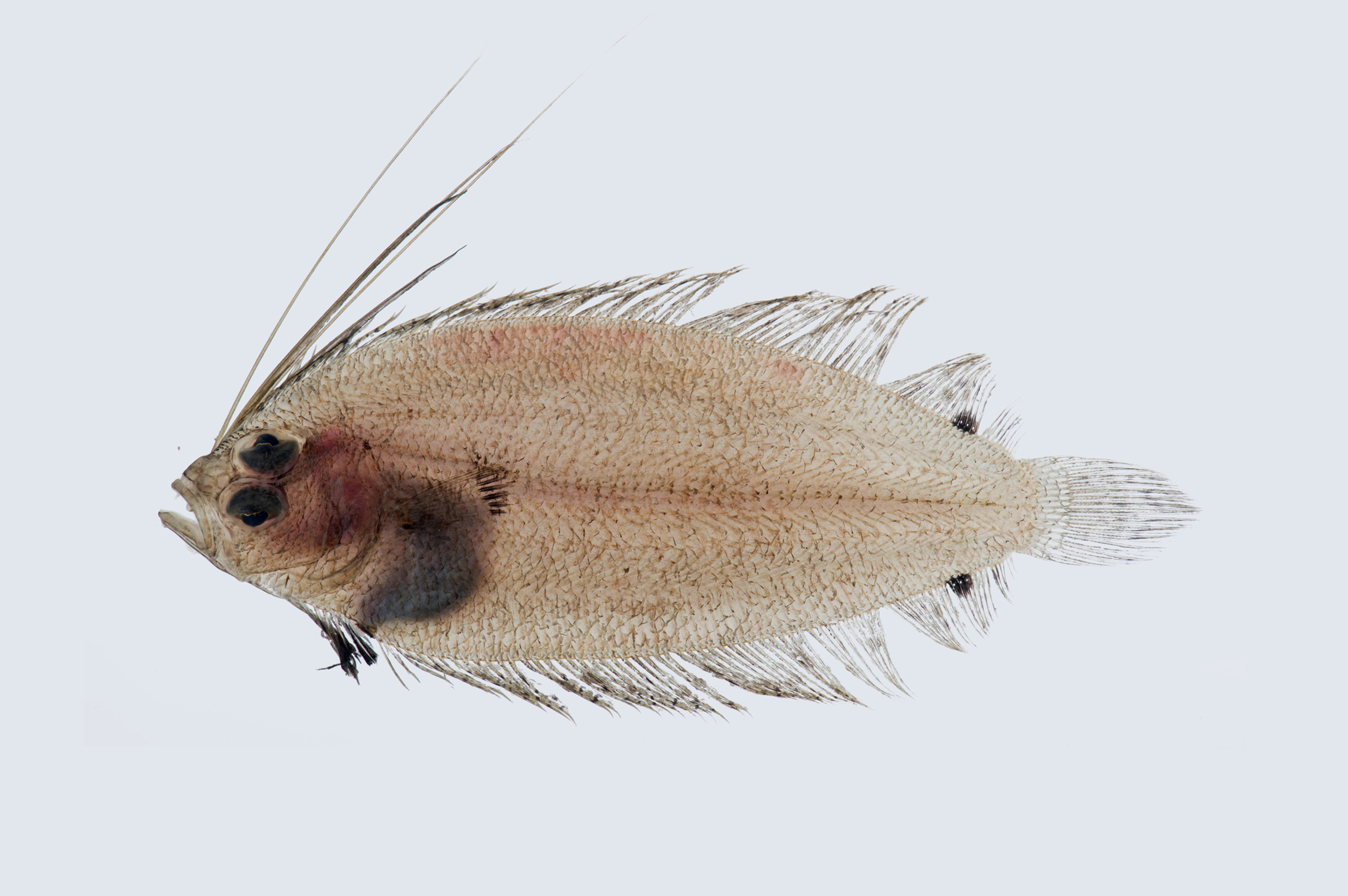- Classification
- ACTINOPTERYGII
- PLEURONECTIFORMES
- BOTHIDAE
- Arnoglossus
- macrolophus
Largecrest Lefteye Flounder, Arnoglossus macrolophus Alcock 1889
Other Names: Largecrested Lefteye Flounder, Large-crested Lefteye Flounder

A male Largecrest Lefteye Flounder, Arnoglossus macrolophus, USNM 443190, from the Philippines, July 2016. Source: Jeffrey T. Williams / Smithsonian Institution, National Museum of Natural History, Department of Vertebrate Zoology, Division of Fishes. License: CC by Attribution-NonCommercial-ShareAlike
Summary:
A pale brownish lefteye flounder with a conspicuous black spot at the rear base of the dorsal and anal fins, the outer part of pectoral fin on eyed side black, and extremely elongate anterior dorsal-fin rays in males greater that about 5 cm in length.
Cite this page as:
Bray, D.J. 2025, Arnoglossus macrolophus in Fishes of Australia, accessed 06 Jul 2025, https://fishesofaustralia.net.au/home/species/942
Largecrest Lefteye Flounder, Arnoglossus macrolophus Alcock 1889
More Info
|
Distribution |
West of Barrow Island, Western Australia, and the Arafura Sea, Northern Territory, to south of Cairns, Queensland. Elsewhere the species is widespread in the tropical, Indo-west Pacific: from the Red Sea and the Persian Gulf to southern Japan, Taiwan, South China Sea, Indo-Australian Archipelago and New Caledonia. Inhabits sand, mud and gravel substrates. |
|
Features |
Dorsal fin 89–94; Anal fin 69–74; Pectoral fin 13–14; Caudal fin 2+13+2=17; Lateral line scales 52–57; Gill rakers 0+10–12=10–12; Vertebrae 10+30–32=40–42. Body elliptical, greatest depth at about midbody (37.3–41.4% SL). Head small, its length about half of body depth (23.3–25.1% SL); front profile of head with slight concavity anterior of upper eye; head profile gentle, same in both sexes. Snout slightly shorter than eye diameter. Rostral spine absent on tip of snout in both sexes. Eye diameter distinctly shorter than upper jaw. No orbital spines in both sexes. Interorbital ridge low, extending from anterior margin of lower eye to posterior margin of upper eye. Mouth moderately large, upper-jaw length on ocular side 8.8–10.1% SL; maxilla extending to or slightly behind anterior margin of lower eye; teeth on both jaws uniserial, closely set, without enlarged anterior teeth. Gill rakers only on lower limb of first arch, slender, pointed at tip and not serrate. Scales on ocular side ctenoid with row of slender ctenii, cycloid on blind side. Anteriormost four to six dorsal-fin rays slender, filamentous, first ray longest, 32.9–64% SL in males, 28.7% SL in females. Pectoral fin on ocular side shorter than head, 11–16% SL, fin on blind-side small. |
|
Colour |
Eyed side pale brownish, dark blotch at junction of straight and curved portions of lateral line, two small blotches on middle of straight portion of lateral line; series of five dark indistinct blotches along dorsal margin and three along ventral margin of body; rear of dorsal and anal fins with conspicuous black blotches basally; blind side yellowish white. |
|
Feeding |
Feeds on benthic invertebrates |
|
Fisheries |
Taken as bycatch in commercial fisheries in parts of its range. |
|
Remarks |
Differs from other species of Arnoglossus in having distinct black spots or blotches on the rear of the dorsal and anal fins,and 4-6 elongate anterior dorsal-fin rays in males. |
|
Etymology |
The specific name macrolophus is from the Latin macro (= long, large) and lophus (= crest) in reference to the elongate anterior dorsal-fin rays of males. |
|
Species Citation |
Arnoglossus macrolophus Alcock 1889, Journal of the Asiatic Society of Bengal 58(23): 280, pl. 18 (fig.2). Type locality: Bay of Bengal, 5 miles south of [Ganjam] Brahmapur, Orissa State, India, eastern Indian Ocean, Investigator station 43, depth 25 fathoms. |
|
Author |
Bray, D.J. 2025 |
|
Resources |
Largecrest Lefteye Flounder, Arnoglossus macrolophus Alcock 1889
References
Alcock, A.W. 1889. Natural History notes from H. M. Indian Marine Survey Steamer Investigator. — No. 10. List of the Pleuronectidae obtained in the Bay of Bengal in 1888 and 1889, with descriptions of new and rare species. Journal of the Asiatic Society of Bengal 58(23): 279-295 pls 16-18 See ref at BHL
Amaoka, K. & Ho, H.-C. 2019. The lefteye flounder family Bothidae (Order Pleuronectiformes) of Taiwan. Zootaxa 4702 (1): 155–215, https://doi.org/10.11646/zootaxa.4702.1.18
Amaoka, K. & Mihara, E. 2000. Pisces Pleuronectiformes: Flatfishes from New Caledonia and adjacent waters. Genus Arnoglossus. Mémoires du Muséum national d'Histoire naturelle, Paris [1936-1950] 184: 783-813
Arai, M. & Amaoka, K. 1996. Arnoglossus macrolophus Alcock (Pleuronectiformes: Bothidae); a valid species distinct from A. tapeinosomus (Bleeker). Ichthyological Research 43(4): 359-365 figs 1-4
Hensley, D.A. & Amaoka, K. 2001. Bothidae. pp. 3799-3841 in Carpenter, K.E. & Niem, T.H. (eds). The Living Marine Resources of the Western Central Pacific. FAO Species Identification Guide for Fisheries Purposes. Rome : FAO Vol. 6 pp. 3381-4218.
Larson, H.K., Williams, R.S. & Hammer, M.P. 2013. An annotated checklist of the fishes of the Northern Territory, Australia. Zootaxa 3696(1): 1-293
Munroe, T. 2016. Arnoglossus macrolophus. The IUCN Red List of Threatened Species 2016: e.T46093091A46664989. https://dx.doi.org/10.2305/IUCN.UK.2016-3.RLTS.T46093091A46664989.en. Downloaded on 19 May 2020.
Russell, B.C. & Houston, W. 1989. Offshore fishes of the Arafura Sea. The Beagle, Records of the Museums and Art Galleries of the Northern Territory 6(1): 69-84





